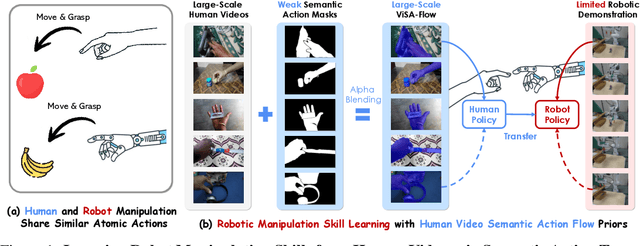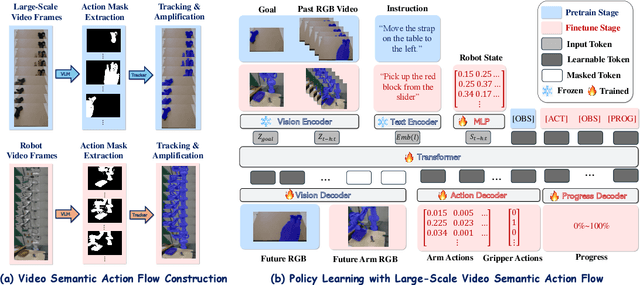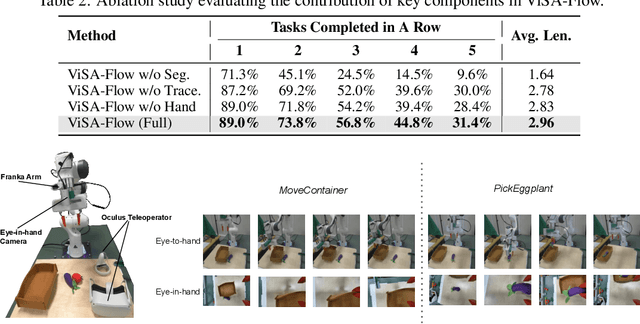Xiaohao Xu
Whole-Body Proprioceptive Morphing: A Modular Soft Gripper for Robust Cross-Scale Grasping
Oct 31, 2025Abstract:Biological systems, such as the octopus, exhibit masterful cross-scale manipulation by adaptively reconfiguring their entire form, a capability that remains elusive in robotics. Conventional soft grippers, while compliant, are mostly constrained by a fixed global morphology, and prior shape-morphing efforts have been largely confined to localized deformations, failing to replicate this biological dexterity. Inspired by this natural exemplar, we introduce the paradigm of collaborative, whole-body proprioceptive morphing, realized in a modular soft gripper architecture. Our design is a distributed network of modular self-sensing pneumatic actuators that enables the gripper to intelligently reconfigure its entire topology, achieving multiple morphing states that are controllable to form diverse polygonal shapes. By integrating rich proprioceptive feedback from embedded sensors, our system can seamlessly transition from a precise pinch to a large envelope grasp. We experimentally demonstrate that this approach expands the grasping envelope and enhances generalization across diverse object geometries (standard and irregular) and scales (up to 10$\times$), while also unlocking novel manipulation modalities such as multi-object and internal hook grasping. This work presents a low-cost, easy-to-fabricate, and scalable framework that fuses distributed actuation with integrated sensing, offering a new pathway toward achieving biological levels of dexterity in robotic manipulation.
Image Tokenizer Needs Post-Training
Sep 15, 2025Abstract:Recent image generative models typically capture the image distribution in a pre-constructed latent space, relying on a frozen image tokenizer. However, there exists a significant discrepancy between the reconstruction and generation distribution, where current tokenizers only prioritize the reconstruction task that happens before generative training without considering the generation errors during sampling. In this paper, we comprehensively analyze the reason for this discrepancy in a discrete latent space, and, from which, we propose a novel tokenizer training scheme including both main-training and post-training, focusing on improving latent space construction and decoding respectively. During the main training, a latent perturbation strategy is proposed to simulate sampling noises, \ie, the unexpected tokens generated in generative inference. Specifically, we propose a plug-and-play tokenizer training scheme, which significantly enhances the robustness of tokenizer, thus boosting the generation quality and convergence speed, and a novel tokenizer evaluation metric, \ie, pFID, which successfully correlates the tokenizer performance to generation quality. During post-training, we further optimize the tokenizer decoder regarding a well-trained generative model to mitigate the distribution difference between generated and reconstructed tokens. With a $\sim$400M generator, a discrete tokenizer trained with our proposed main training achieves a notable 1.60 gFID and further obtains 1.36 gFID with the additional post-training. Further experiments are conducted to broadly validate the effectiveness of our post-training strategy on off-the-shelf discrete and continuous tokenizers, coupled with autoregressive and diffusion-based generators.
Bridging 3D Anomaly Localization and Repair via High-Quality Continuous Geometric Representation
May 30, 2025



Abstract:3D point cloud anomaly detection is essential for robust vision systems but is challenged by pose variations and complex geometric anomalies. Existing patch-based methods often suffer from geometric fidelity issues due to discrete voxelization or projection-based representations, limiting fine-grained anomaly localization. We introduce Pose-Aware Signed Distance Field (PASDF), a novel framework that integrates 3D anomaly detection and repair by learning a continuous, pose-invariant shape representation. PASDF leverages a Pose Alignment Module for canonicalization and a SDF Network to dynamically incorporate pose, enabling implicit learning of high-fidelity anomaly repair templates from the continuous SDF. This facilitates precise pixel-level anomaly localization through an Anomaly-Aware Scoring Module. Crucially, the continuous 3D representation in PASDF extends beyond detection, facilitating in-situ anomaly repair. Experiments on Real3D-AD and Anomaly-ShapeNet demonstrate state-of-the-art performance, achieving high object-level AUROC scores of 80.2% and 90.0%, respectively. These results highlight the effectiveness of continuous geometric representations in advancing 3D anomaly detection and facilitating practical anomaly region repair. The code is available at https://github.com/ZZZBBBZZZ/PASDF to support further research.
Visual Anomaly Detection under Complex View-Illumination Interplay: A Large-Scale Benchmark
May 16, 2025Abstract:The practical deployment of Visual Anomaly Detection (VAD) systems is hindered by their sensitivity to real-world imaging variations, particularly the complex interplay between viewpoint and illumination which drastically alters defect visibility. Current benchmarks largely overlook this critical challenge. We introduce Multi-View Multi-Illumination Anomaly Detection (M2AD), a new large-scale benchmark comprising 119,880 high-resolution images designed explicitly to probe VAD robustness under such interacting conditions. By systematically capturing 999 specimens across 10 categories using 12 synchronized views and 10 illumination settings (120 configurations total), M2AD enables rigorous evaluation. We establish two evaluation protocols: M2AD-Synergy tests the ability to fuse information across diverse configurations, and M2AD-Invariant measures single-image robustness against realistic view-illumination effects. Our extensive benchmarking shows that state-of-the-art VAD methods struggle significantly on M2AD, demonstrating the profound challenge posed by view-illumination interplay. This benchmark serves as an essential tool for developing and validating VAD methods capable of overcoming real-world complexities. Our full dataset and test suite will be released at https://hustcyq.github.io/M2AD to facilitate the field.
ViSA-Flow: Accelerating Robot Skill Learning via Large-Scale Video Semantic Action Flow
May 02, 2025



Abstract:One of the central challenges preventing robots from acquiring complex manipulation skills is the prohibitive cost of collecting large-scale robot demonstrations. In contrast, humans are able to learn efficiently by watching others interact with their environment. To bridge this gap, we introduce semantic action flow as a core intermediate representation capturing the essential spatio-temporal manipulator-object interactions, invariant to superficial visual differences. We present ViSA-Flow, a framework that learns this representation self-supervised from unlabeled large-scale video data. First, a generative model is pre-trained on semantic action flows automatically extracted from large-scale human-object interaction video data, learning a robust prior over manipulation structure. Second, this prior is efficiently adapted to a target robot by fine-tuning on a small set of robot demonstrations processed through the same semantic abstraction pipeline. We demonstrate through extensive experiments on the CALVIN benchmark and real-world tasks that ViSA-Flow achieves state-of-the-art performance, particularly in low-data regimes, outperforming prior methods by effectively transferring knowledge from human video observation to robotic execution. Videos are available at https://visaflow-web.github.io/ViSAFLOW.
Robust Latent Matters: Boosting Image Generation with Sampling Error
Mar 11, 2025



Abstract:Recent image generation schemes typically capture image distribution in a pre-constructed latent space relying on a frozen image tokenizer. Though the performance of tokenizer plays an essential role to the successful generation, its current evaluation metrics (e.g. rFID) fail to precisely assess the tokenizer and correlate its performance to the generation quality (e.g. gFID). In this paper, we comprehensively analyze the reason for the discrepancy of reconstruction and generation qualities in a discrete latent space, and, from which, we propose a novel plug-and-play tokenizer training scheme to facilitate latent space construction. Specifically, a latent perturbation approach is proposed to simulate sampling noises, i.e., the unexpected tokens sampled, from the generative process. With the latent perturbation, we further propose (1) a novel tokenizer evaluation metric, i.e., pFID, which successfully correlates the tokenizer performance to generation quality and (2) a plug-and-play tokenizer training scheme, which significantly enhances the robustness of tokenizer thus boosting the generation quality and convergence speed. Extensive benchmarking are conducted with 11 advanced discrete image tokenizers with 2 autoregressive generation models to validate our approach. The tokenizer trained with our proposed latent perturbation achieve a notable 1.60 gFID with classifier-free guidance (CFG) and 3.45 gFID without CFG with a $\sim$400M generator. Code: https://github.com/lxa9867/ImageFolder.
Towards Ambiguity-Free Spatial Foundation Model: Rethinking and Decoupling Depth Ambiguity
Mar 08, 2025



Abstract:Depth ambiguity is a fundamental challenge in spatial scene understanding, especially in transparent scenes where single-depth estimates fail to capture full 3D structure. Existing models, limited to deterministic predictions, overlook real-world multi-layer depth. To address this, we introduce a paradigm shift from single-prediction to multi-hypothesis spatial foundation models. We first present \texttt{MD-3k}, a benchmark exposing depth biases in expert and foundational models through multi-layer spatial relationship labels and new metrics. To resolve depth ambiguity, we propose Laplacian Visual Prompting (LVP), a training-free spectral prompting technique that extracts hidden depth from pre-trained models via Laplacian-transformed RGB inputs. By integrating LVP-inferred depth with standard RGB-based estimates, our approach elicits multi-layer depth without model retraining. Extensive experiments validate the effectiveness of LVP in zero-shot multi-layer depth estimation, unlocking more robust and comprehensive geometry-conditioned visual generation, 3D-grounded spatial reasoning, and temporally consistent video-level depth inference. Our benchmark and code will be available at https://github.com/Xiaohao-Xu/Ambiguity-in-Space.
Towards Visual Discrimination and Reasoning of Real-World Physical Dynamics: Physics-Grounded Anomaly Detection
Mar 06, 2025Abstract:Humans detect real-world object anomalies by perceiving, interacting, and reasoning based on object-conditioned physical knowledge. The long-term goal of Industrial Anomaly Detection (IAD) is to enable machines to autonomously replicate this skill. However, current IAD algorithms are largely developed and tested on static, semantically simple datasets, which diverge from real-world scenarios where physical understanding and reasoning are essential. To bridge this gap, we introduce the Physics Anomaly Detection (Phys-AD) dataset, the first large-scale, real-world, physics-grounded video dataset for industrial anomaly detection. Collected using a real robot arm and motor, Phys-AD provides a diverse set of dynamic, semantically rich scenarios. The dataset includes more than 6400 videos across 22 real-world object categories, interacting with robot arms and motors, and exhibits 47 types of anomalies. Anomaly detection in Phys-AD requires visual reasoning, combining both physical knowledge and video content to determine object abnormality. We benchmark state-of-the-art anomaly detection methods under three settings: unsupervised AD, weakly-supervised AD, and video-understanding AD, highlighting their limitations in handling physics-grounded anomalies. Additionally, we introduce the Physics Anomaly Explanation (PAEval) metric, designed to assess the ability of visual-language foundation models to not only detect anomalies but also provide accurate explanations for their underlying physical causes. Our dataset and benchmark will be publicly available.
Large Language Models as Natural Selector for Embodied Soft Robot Design
Mar 04, 2025



Abstract:Designing soft robots is a complex and iterative process that demands cross-disciplinary expertise in materials science, mechanics, and control, often relying on intuition and extensive experimentation. While Large Language Models (LLMs) have demonstrated impressive reasoning abilities, their capacity to learn and apply embodied design principles--crucial for creating functional robotic systems--remains largely unexplored. This paper introduces RoboCrafter-QA, a novel benchmark to evaluate whether LLMs can learn representations of soft robot designs that effectively bridge the gap between high-level task descriptions and low-level morphological and material choices. RoboCrafter-QA leverages the EvoGym simulator to generate a diverse set of soft robot design challenges, spanning robotic locomotion, manipulation, and balancing tasks. Our experiments with state-of-the-art multi-modal LLMs reveal that while these models exhibit promising capabilities in learning design representations, they struggle with fine-grained distinctions between designs with subtle performance differences. We further demonstrate the practical utility of LLMs for robot design initialization. Our code and benchmark will be available to encourage the community to foster this exciting research direction.
Scalable Benchmarking and Robust Learning for Noise-Free Ego-Motion and 3D Reconstruction from Noisy Video
Jan 24, 2025Abstract:We aim to redefine robust ego-motion estimation and photorealistic 3D reconstruction by addressing a critical limitation: the reliance on noise-free data in existing models. While such sanitized conditions simplify evaluation, they fail to capture the unpredictable, noisy complexities of real-world environments. Dynamic motion, sensor imperfections, and synchronization perturbations lead to sharp performance declines when these models are deployed in practice, revealing an urgent need for frameworks that embrace and excel under real-world noise. To bridge this gap, we tackle three core challenges: scalable data generation, comprehensive benchmarking, and model robustness enhancement. First, we introduce a scalable noisy data synthesis pipeline that generates diverse datasets simulating complex motion, sensor imperfections, and synchronization errors. Second, we leverage this pipeline to create Robust-Ego3D, a benchmark rigorously designed to expose noise-induced performance degradation, highlighting the limitations of current learning-based methods in ego-motion accuracy and 3D reconstruction quality. Third, we propose Correspondence-guided Gaussian Splatting (CorrGS), a novel test-time adaptation method that progressively refines an internal clean 3D representation by aligning noisy observations with rendered RGB-D frames from clean 3D map, enhancing geometric alignment and appearance restoration through visual correspondence. Extensive experiments on synthetic and real-world data demonstrate that CorrGS consistently outperforms prior state-of-the-art methods, particularly in scenarios involving rapid motion and dynamic illumination.
 Add to Chrome
Add to Chrome Add to Firefox
Add to Firefox Add to Edge
Add to Edge